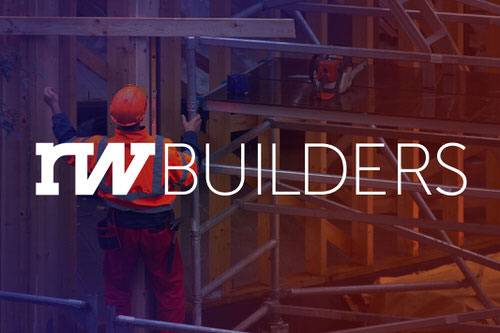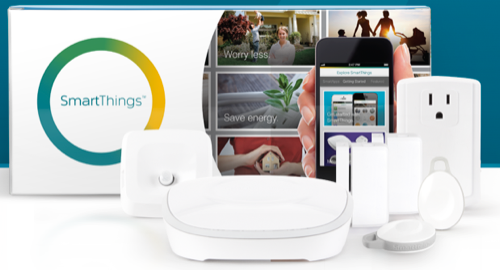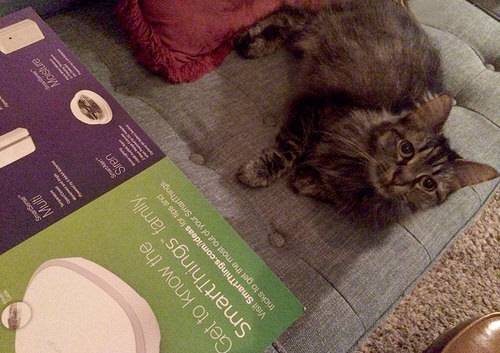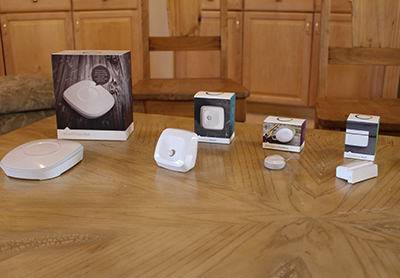
ReadWriteBuilders is a series of interviews with developers, designers and other architects of the programmable future.
Alex Hawkinson just wanted some peace of mind. But when he went looking for a simple, affordable way to monitor his family’s house when he wasn’t around, all he found was frustration.
So instead of throwing up his hands, Hawkinson built his own.
Two years ago, his startup, SmartThings, took to Kickstarter with plans for a connected home hub and sensors. The goal was $250,000; it raised $1.2 million dollars. Investors kicked in another $12.5 million last year just before the Consumer Electronics Show, where the company unveiled its own platform called SmartThings Labs.
And now that technology is one of several nascent building blocks of the Internet of Things.
How A Cabin Disaster Turned Into Opportunity
ReadWrite: I read that SmartThings was born out of a family-home disaster that cost $80,000 in damages. What happened?
Alex Hawkinson: We have a family home in the mountains. When we went for a winter trip in February 2011, we found it totally destroyed by moisture. The electricity went out, and the pipes froze and burst. The electricity came back on, and the water ran through the walls, ceilings and floors for at least a couple of months before we found it. It drove me nuts. It was so costly.
If we’d known what was happening, we could have called the handyman down the road.

RW: So that disaster planted the seed for SmartThings?
AH: There were two big a-ha moments. After we repaired the damage, I searched for a sensor to just plug in, so I’d know if something went wrong. But I couldn’t find anything as a consumer. My daughter was watching streaming media on her iPhone, and I thought, “Why hasn’t somebody made this really easy?”
It’s crazy that it takes a professional to install and a big monthly fee. So we started with the idea of building a sensor box with cellular radio equipment, to make it easy for people to keep track of their homes. We had a working prototype within a few months.
Then we had a much bigger idea. We looked at how it would work with other companies building connected things. There was a big wave of people creating connected devices, but no one had created a central cloud, app, user experience and platform for the Internet of Things and the connected home.
That’s when we snapped into a much bigger vision of embracing the product community and inventors.

RW: You mentioned “we.” There are seven co-founders of SmartThings. Was it tough getting things done as a group?
AH: My parents were head hunters with an executive search firm, and I grew up with team dynamics being everything around the dinner table.
I’ve worked with Jeff Hagins, our CTO, all the way back to three companies ago. The last company was called SMBLive, a cloud software company that had a small business product, and the seven co-founders were all co-founders there as well. [There can be] some downside, if you need to get everyone aligned. But it’s mostly really good upside, because we have different skill sets, and we can quickly tackle fairly complicated problems.
Hardware Really Is Hard
RW: It’s only been two years since your Kickstarter campaign. Did anything surprise you about that experience? Did any unique challenges come up?
AH: One thing was the readiness and appetite of the consumer market for this right now. When we started, we didn’t plan on doing Kickstarter. It was really about community development, and seeing what people had to say. We were surprised by how big the Kickstarter campaign was. We hoped for 1,000 households and maybe 100 developers. We had nearly 10,000 households and 1,000 developers and device makers signed up.
I guess on the challenges front, having been in the hardware business, [it’s] the long, slow-moving dynamics. People jokingly say, “Hardware is called hardware for a reason—it’s hard.” It has all these certification layers, and all of these other inhibitors, and you don’t have the software to get things done really quickly. But I think we’ve been pretty fast.

RW: Did you have any hardware experience to guide you?
AH: I didn’t have any then, and that’s kind of crazy, looking back at how fast things evolved over the past couple of years. Things like 3D printing and robotics-based manufacturing are breaking down barriers to making connected things. So I thought, “Oh, we should be able to create something that thousands of entrepreneurs have now.”
But I realized that the Internet of Things is as much, or more, of a software problem as it is a hardware problem. There’s a hardware renaissance right now, but what’s missing is the software layer that brings them together. That’s the goal we set out. So we brought in the expertise to build the hardware.
RW: What was it like, focusing on hardware and software, or really platform development, right out of the gate?
AH: It was crazy and rushed, how fast things have evolved. Our vision was to make it the easiest way for consumers to turn their home into a smart home. And make that available to everyday people, not just hackers and gadget people. We also wanted to make an open platform—to embrace the developers, the Web apps and the mobile apps, and bring their innovation.
We’re not a device company, [but] we realized we had to make some hardware—the hub and these sensors—to make it easy, out of the box, for everyday people to get started.

RW: Is that why you decided to go with the paper pull tab? [This is a tab similar to those battery tabs you sometimes find in small electronic gadgets. Pull it out of a SmartThings device and it auto-connects to the hub.]
AH: We saw that a lot of connected device companies unbelievably were still ignoring the top-to-bottom user experience. There were products that would technically work together with a hub like ours. But we knew that initial, straight-out-of-the-box experience was critical from the beginning, [especially] for people who have never touched these technologies before.
Platform In A Box
RW: Some connected home products rely on Wi-Fi alone, but you decided to support Zigbee and Z-Wave [wireless home-automation networks]. Why?
AH: There are multiple standards for connecting things in your home. Wi-Fi is obviously very prevalent; it works well for things that are plugged in and need a lot of bandwidth. But it doesn’t have that great of a range, and it doesn’t work well for battery-powered devices, like the sensors you put everywhere. These standards have different strengths, and we wanted to account for many different scenarios without having to wire everything up.
We could have put even more radios into the hub, but we had to consider price. Eventually, the goal is to give it away for free. We decided to bet on the standards were most likely to be successful, instead of packing in so much, it becomes expensive and complicated for people. So we decided on Wi-Fi, Zigbee, Z-Wave and cloud-connected devices.
You can go buy a lot of things now that can work with SmartThings, and a lot more in the future. We wanted to build that into our own devices from the start.

RW: Let’s talk about SmartThings Labs. I met your COO, Andrew Brooks, in Las Vegas during CES 2014, and he seemed pretty excited about it.
AH: It’s been crazy. As an open platform, we have a fully live IDE—integrated development environment—and toolkit for both developers and device makers, on the Kickstarter base of a thousand people who signed up. It’s more than 5,000 active developers and device makers on the platform now.
Before CES, everyone was building things privately. They build apps for their own environments and device types for their own experimentation. We hadn’t begun opening all of the innovation that was happening on the platform to the rest of the userbase. And SmartThings Labs was the first step toward doing that.
There are tractions for a lot of common device types like Sonos, the voice of your smart home. Also Philips lighting and Belkin WeMo. Those are just the first few examples.
RW: What’s your favorite Labs example?
AH: The Sonos stuff, for sure. I love that the developer community came up with that. At first, it just played music when I woke up and came back after work. I love [the idea] of having sound ambiently reflect and know what’s happening in our lives. But I never contemplated the notion that Sonos could act like a virtual guard dog.
When there’s motion on my front porch, it sounds like I have a massive pack of dogs. I think that’s a cool example. It’s a good combination of a good device, platform and developer that came up with the idea.
RW: You’re very dedicated to being an open platform. Did you have doubts along the way about that decision?
AH: There have been moments that tested our resolve. But we knew that the place for us was in the connected user experience, in the applications that exist between all these devices.
There are literally thousands of companies inventing new connected things, [but] most of the things that will fill our homes haven’t been invented yet. We believe they’re coming from new entrepreneurs and other startups that are going to emerge. There needs to be someone who embraces that wave of invention, who doesn’t try to do it all themselves. We’ve been firm about that decision, and our momentum right now is validating that choice.
RW: Google bought Nest. Are you concerned about the search giant laying a bigger hand on the home?
AH: No. Now, nobody ever wants to see Google as a competitor, but I viewed it as a really positive opportunity.
Nest has always made beautiful things. They’re going to have ability to do more beautiful things at scale now, with Google’s resources. But the issue with them is that they haven’t been open. Our developer community has had to hack together connectivity with Nest. Hopefully with Google’s historic stance towards openness, it would make things even easier.
Also, it’s a big marketplace, and we have a lot of potential partners building things on top of SmartThings—services, connected apps and new devices. But other large players are just realizing how big this space can be [thanks to that deal], so they’re starting to make their bets. That’s benefitting us directly. It’s been an injection of rocket fuel into a lot of those discussions.
RW: Smartphones are the lynchpin for your smart home. Will you push that onto, say, wrists or glasses? I hear something with Jawbone UP is in the works.
AH: Jawbone will be released in Labs soon. [Since] it can track your body’s data, it knows when you’re home, when you actually fall asleep at night, or when you wake up. Imagine when you fall asleep, it secures the home and adjusts the thermostat to your perfect sleeping temperature. Likewise when you wake up, you don’t have to disarm a security system. It just knows you’re awake, and it takes advantage of that.
It becomes more intelligent by adding a connection to wearable sensors. We see developers doing even more creative things, like using the button on the Jawbone as a second factor in authentication as you’re arriving home. That combination of events makes it more secure than if it’s just your phone triggering it.
The Physical Graph = The Programmable World
RW: I talked with [COO] Andrew about security. You have a lot of encryption at different levels, from the devices to the hub, between the hub and your cloud, at the backend, etc. Do security concerns ever hold you back from innovating?
AH: It does. [But it’s] finding the right balance between open innovation, which is core to our vision, and protecting user privacy and security. I think the winning companies are going to take security and privacy as core design tenets built in from the beginning, not after the fact. We definitely have that attitude.
There’s not that much that can go wrong with, say, basic sensor data. On the other hand, what services can trigger your door to unlock, right? Or a high voltage appliance to turn on? Those applications need more scrutiny. So part of it is security architecture and policies, and another part is building the processes for how we let innovation happen, but with checks and balances.
This is something you take seriously from the beginning. But by and large, the benefits of these technologies far outweigh the risks.
RW: If you could go back and do this over again, is there anything you would have done differently?
AH: With SmartThings, I think we’d all put down another mortgage on our houses and fund it. We would have thrown everything in. We’ve raised quite a bit of capital now with some of the best VCs in the world. I might have delayed that another few months.
We’re going after the “physical” graph, as we call it. We think it’s going to be the next big technology wave.
RW: Tell me about this “physical graph.”
AH: The backdrop to that is the knowledge and social graphs. They’re two of the biggest technology trends of the last 15 years.
The knowledge graph is the digitization of all human information and human knowledge. Companies like Google organize that, enabling it and changing how you find things that you want to buy, or find information that is important to you. The social graph is the digitization of human relationships.
In that context, the physical graph is the digitization of all the physical things in the world, connecting everyday things to the Internet in some format. What happens as a result: the whole world and offline objects becomes programmable with software in a way that it wasn’t before. The programmable world is another term [describing how] no facet of life won’t be touched by this wave.
We’re looking at debugging how you want your house to respond around your life. It’s a whole new problem set that people are starting to glom onto.










